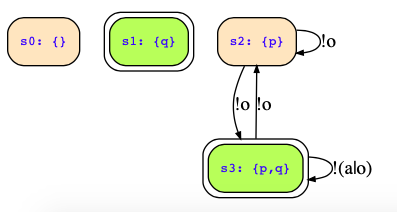I have the following conditions. I = q and R = !(a&q&next(q)|(next(p)->(p->o))).
Upon generating the CDNF i have the following minterms:
p&!q&!a&!o&next(p)&next(q)
p&!q&a&!o&next(p)&next(q)
p&!q&!a&!o&next(p)&!next(q)
p&q&a&!o&next(p)&!next(q)
p&q&!a&!o&next(p)&!next(q|
p&q&!a&!o&next(p)&next(q)
p&!q&a&!o&next(p)&!next(q)
Following these I generated this FSM.

I am trying to submit the following solution:
init 1,3;
transitions (2,{a},{},2); (2,{},{},2); (2,{a},{},3); (2,{},{},3); (3,{a},{},2); (3,{},{},2); (3,{},{},3);
Which for some reason is not being accepted. I have tried with and without state 1 as initial state.
Please Help.
Thankyou.